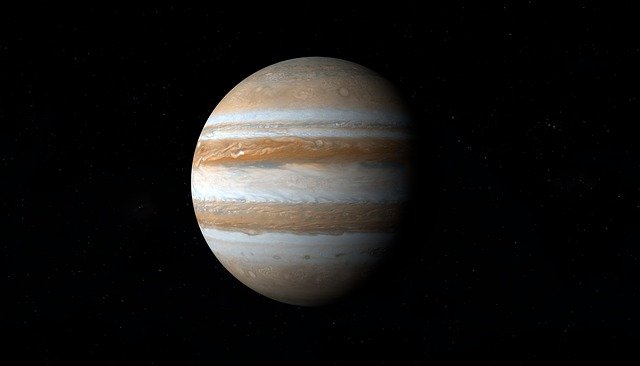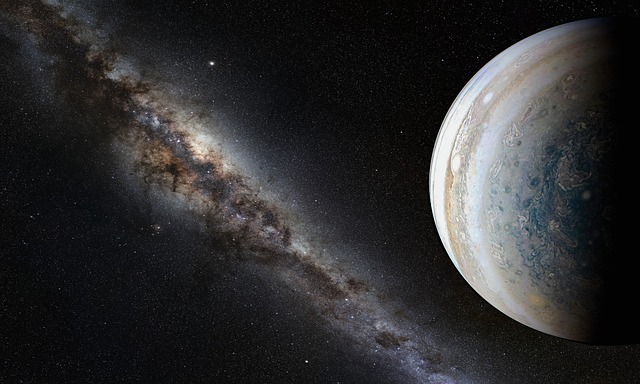*This post may contain affiliate links. This means we may make a commission if you purchase an item using one of our links*
Jupiter is not tidally locked to the sun, any of its own moons, or any other planet. Jupiter’s distance from the Sun and other planets, combined with its enormous size, prevents it from becoming tidally locked. That being said, all of Jupiter’s major moons are tidally locked to Jupiter, but not the other way around.
Tidal locking, like the name suggests, is what causes the tides in our own oceans here on Earth. The phenomenon of tidal locking occurs when a stellar body’s rotating period coincides with its orbital period around a companion stellar body due to gravitational forces.
This means the tidally locked stellar body will face its companion with the same side always, because the stellar body is locked in place.
So, the moon is tidally locked to the Earth through gravity, but what about the largest planet in the solar system? Is Jupiter tidally locked?
Why Isn’t Jupiter Tidally Locked?
There are three types of solar bodies that Jupiter could potentially be tidally locked to: the Sun, it’s moons, and the other planets in the solar system.
Sun
For a planet to become tidally locked to its sun, it must orbit incredibly close. Mercury, the closest planet to the Sun in our solar system, isn’t even close enough to be tidally locked. It’s speculated that the planet would need to have an orbit 1/10th as small as Mercury’s orbit to become tidally locked to its sun.
Since Jupiter is the 5th planet in our solar system, it’s exceptionally far from our Sun, 464.93 million miles to be exact. At that distance, the Sun’s gravitational influence on Jupiter is nowhere near strong enough to tidally lock Jupiter.
Jupiter’s Moons
The same is true for Jupiter’s moons, but instead of distance being the contributing factor, size is what causes Jupiter to not be tidally locked to its moons. Jupiter is larger than all of its moons, so its gravitational pull is stronger than that of the moons.
Since Jupiter is larger than its moons and has a stronger gravitational pull, this means the moons will be tidally locked to Jupiter, but Jupiter will not be tidally locked to the moons.
Other Planets
Jupiter isn’t tidally locked to any other planet because of both distance and size. Jupiter is the largest planet in our solar system, so it has a strong enough gravitational pull that it wouldn’t be able to be tidally locked onto a smaller planet.
In fact, none of our solar system’s planets, whether it be Earth, Venus or Mars none are tidally locked with each other!
Jupiter is also very far from any other plant, with the closest planet being Mars at 342 million miles away. At this distance, even if Jupiter was smaller, it wouldn’t be able to become tidally locked to any other planet, including Mars.
Is Jupiter Tidally Locked To All Its Moons?

No, Jupiter is not tidally locked to any of its moons.
In order for a planet to be tidally locked to something, the object it is locked to must exert tremendous gravitational force on the planet. Jupiter is much larger than all of its moons, so it cannot be tidally locked to them
Are All Of Jupiter’s Moons Tidally Locked?
Yes, all of Jupiter’s moons, whether Europa, Io among many other are tidally locked, with the possible exception of the distant retrograde moons.
Jupiter has an exceptional number of moons. At the most recent count, it has 80 named moons orbiting it. They are split up into several groups, but the most notable are the regular satellites:
The Galilean Moons
Jupiter’s major moons, the Galilean moons, are the largest Jovian moons. The Galilean moons are Europa, Io, Callisto, and Ganymede. All four moons are significant solar bodies with unique features, and they are all tidally locked to their parent planet, Jupiter.
Amalthea Group
Closer to Jupiter, but much smaller than the Gailiean moons, are the Amalthea group moons. This group is also tidal locked, and consists of the moons Metis, Adrastea, Amalthea, and Thebe.
Irregular Satellites
Besides the regular satellites, there are several moons that are considered irregular satellites.
Three of these moons, Valetudo, Themisto, and Carpo, don’t belong to any families, but the rest of the irregular satellites are grouped together.
The irregular satellite groupings, ranked by distance from Jupiter, are:
- Himalia Group
- Ananke Group
- Carme Group
- Pasiphae Group
The first grouping, Himalia group, has a prograde orbit, and all of its moons are tidally locked. It’s the last three groupings, Ananke, Carme, and Pasiphae, that have retrograde orbits and could potentially not be tidally locked.
Why Are All Of Jupiter’s Moons Not Tidally Locked?
Becoming tidally locked takes time, sometimes millions of years, and some of Jupiter’s retrograde moons may not have been part of Jupiter’s orbit long enough to become tidally locked.
Most of Jupiter’s retrograde moons are tiny, and not much is known about many of them. This makes it hard for astronomers to determine if these irregular satellites are tidally locked or not.
Summary
Tidal lock is a complex subject, especially in the case of our solar systems largest planet, Jupiter, and its 80 moons.
- Jupiter is not tidally locked to the Sun, its own moons, or any other planet.
- Jupiter is too far from the Sun to be tidally locked, and too large to be tidally locked to anything else.
- Jupiter’s moons are all tidally locked to Jupiter. The only potential exception are Jupiter’s retrograde irregular satellites.
References
https://astronomy.com/magazine/ask-astro/2012/02/planetary-dynamics

